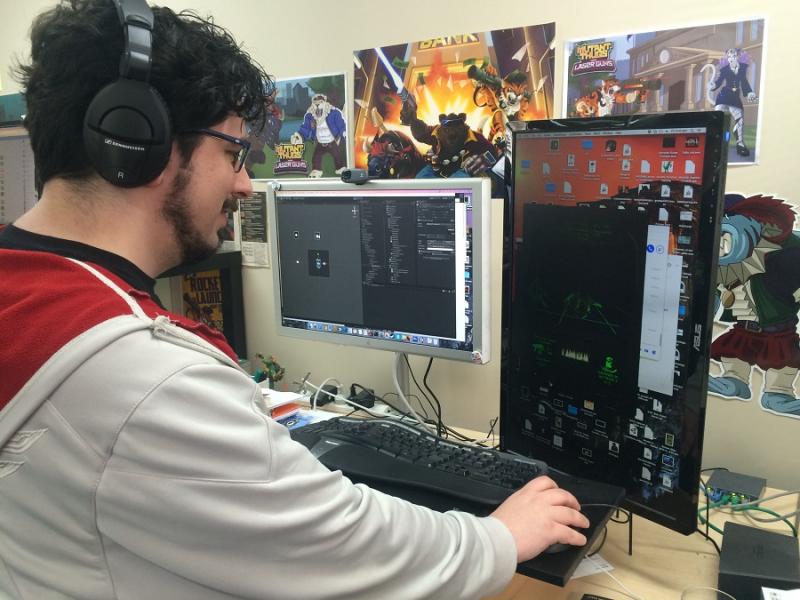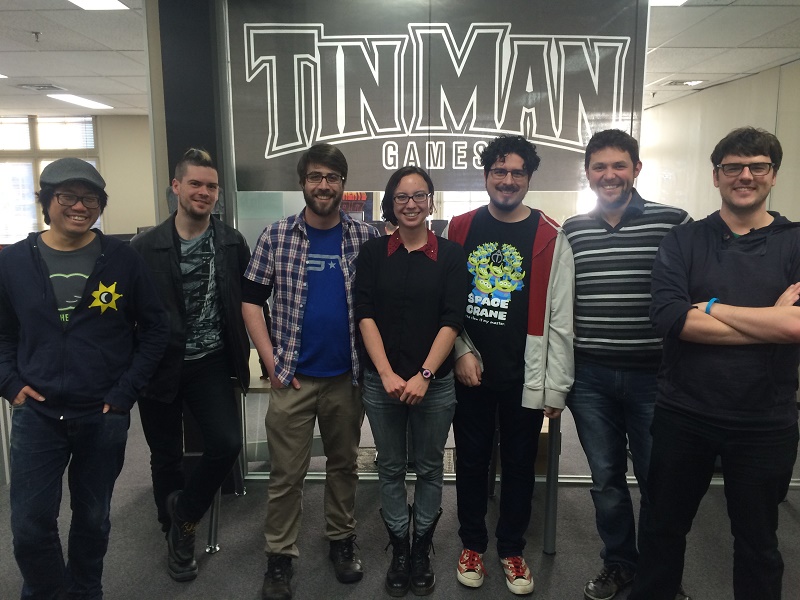We Made It: Tin Man update the gamebook | reviews, news & interviews
We Made It: Tin Man update the gamebook
We Made It: Tin Man update the gamebook
The Melbourne-based company creating electronic nostalgia

Back in the 1980s, parents and teachers alike worried that a generation of kids would drift away from reading and be seduced by the immersive delights of computer gaming. What many kids knew, however, was that you didn’t have to choose between books and games at all. A peculiar hybrid of the two - the gamebook - became a minor publishing phenomenon.
A quick primer if you somehow missed the gamebook's brief moment in the sun. A gamebook is a branching narrative composed of numbered paragraphs, usually written in the second person - as the blurb on each Fighting Fantasy book put it, YOU are the hero! Each paragraph would end in a choice that would lead to other paragraphs. (You are in a small room with two exits. To use the wooden door to the north, turn to 223. To go east through the iron gate, turn to 372.) Sometimes you might have to roll a dice to decide the outcome of a fight or whether you were lucky enough to grab the vine as you fell from the edge of a cliff... and so on.
Gamebooks eventually fell out of fashion, partly due to a two-pronged attack from compelling children's books and more convincing video games, but a number of enthusiasts kept the faith and, as smartphone gaming took off, several gamebook-inspired games have been published by indie developers.
 One such developer is Tin Man Games. Founded by British games designer Neil Rennison (pictured right) in 2009, Tin Man produced its own line of moderately successful Gamebook Adventures games before winning the licence to produce official electronic conversions of the original Fighting Fantasy books.
One such developer is Tin Man Games. Founded by British games designer Neil Rennison (pictured right) in 2009, Tin Man produced its own line of moderately successful Gamebook Adventures games before winning the licence to produce official electronic conversions of the original Fighting Fantasy books.
"I spoke to Steve [Jackson] some years ago about the Fighting Fantasy licence, but it had recently been signed up by another games company," explains Rennison. "Gamebook Adventures was still in the early days of development so I was probably jumping the gun a bit. Fast forward a few years and seven or eight releases later I met Ian at Dragonmeet in London. He was in the middle of writing Blood of the Zombies for the 30th anniversary of Fighting Fantasy and approached me to see if we wanted to develop the app for it. Around the same time the overall FF app licence was coming to an end with the existing holders and they decided not to renew, so it was offered to us and we were of course very excited and signed on the dotted line!"
Rennison and the core team of developers work out of a development hub in Melbourne's Central Business District, in a small office packed to the roof with shelves of gamebooks, tabletop games and miniatures. "Most of our writers work remotely, some on the other side of the planet," explains Neil. "We've developed a gamebook editing tool called Mercury Mouse that allows collaboration, as all the files are saved to and loaded from the cloud. These files also sync up to every device in the world where our games are installed, which allows us to fix spelling, grammar and minor bugs quickly and efficiently.
"Our illustrators are remote and we work over email or Skype to direct briefs and provide feedback. We've hired an internal artist in the office recently, but he's more of a 3D modeller and shader tech guy, which I think says a lot about the direction we’re taking with some of our future projects."
In converting the Fighting Fantasy books, Tin Man isn't quite creating an e-book in the sense of a title published on Kindle, but rather an interactive virtual object that can be very similar to the actual paper book. (Pictured below, Tin Man Games team)
 "In terms of The Forest of Doom we actually made a conscious effort not to change too much," says Rennison. "We wanted it to be our love letter to the Fighting Fantasy series. I have very fond memories of being a 10-year-old playing that gamebook in the mid-Eighties, which introduced me to a world of interactive fantasy. It was important to us to capture as much nostalgia as possible in the app so that other thirty- and fortysomethings would sink back into their childhood and visit an old friend."
"In terms of The Forest of Doom we actually made a conscious effort not to change too much," says Rennison. "We wanted it to be our love letter to the Fighting Fantasy series. I have very fond memories of being a 10-year-old playing that gamebook in the mid-Eighties, which introduced me to a world of interactive fantasy. It was important to us to capture as much nostalgia as possible in the app so that other thirty- and fortysomethings would sink back into their childhood and visit an old friend."
Much of the appeal of Tin Man’s games comes from a sense of nostalgia and in allowing fans to relive an experience from their childhood while on their mobile phones. The designers take great pains to emulate the look and feel of the originals where they can, even down to simulating the ability to cheat when rolling the virtual dice.
"I think our apps perfectly capture that nostalgic book feel, but in a digital way. The only thing we can’t do is provide that musty smell you sometimes get from old gamebooks. I’m proud that we’ve been able to become one of the key players in the re-emergence of gamebooks in the digital space, if not the key player when it comes to the old school format.
“Dice are such a key component for gamebooks, so getting the dice to feel just right was super-important. We even added the little nudge if you feel like the roll might not go your way – the fans always say how much they love that. Essentially everyone cheated when reading the old books and people want that choice.
“As a company, though, we can’t simply rest on nostalgia, and we’re making huge strides in the next 12 months to take gamebooks to a new level. The Warlock of Firetop Mountain will be released early next year on [PC games marketplace] Steam, and while the gamebook will be very much intact, the presentation and core gaming mechanics may be a little more familiar to modern gaming audiences. Watch this space – exciting times are ahead!”
“Ultimately though, modern adventure gaming is simply an extension of the gamebooks of old. Bioware and Bethesda games, for example, even now have choice based narratives that mimic decision trees in gamebooks. It shows that the base structure of interactive narrative is actually more familiar to modern gaming audiences than they might expect and that shows that those morale choices still resonate strongly.”
Read other articles in We Made It, our series on craft in partnership with Bruichladdich
Explore topics
Share this article
The future of Arts Journalism
You can stop theartsdesk.com closing!
We urgently need financing to survive. Our fundraising drive has thus far raised £49,000 but we need to reach £100,000 or we will be forced to close. Please contribute here: https://gofund.me/c3f6033d
And if you can forward this information to anyone who might assist, we’d be grateful.

Subscribe to theartsdesk.com
Thank you for continuing to read our work on theartsdesk.com. For unlimited access to every article in its entirety, including our archive of more than 15,000 pieces, we're asking for £5 per month or £40 per year. We feel it's a very good deal, and hope you do too.
To take a subscription now simply click here.
And if you're looking for that extra gift for a friend or family member, why not treat them to a theartsdesk.com gift subscription?
more We made it
 We Made It: Guitar Maker Brian Cohen
The incredible one-man string band
We Made It: Guitar Maker Brian Cohen
The incredible one-man string band
 We Made It: Basket-maker Lois Walpole
Weaving works of art from 'ghost gear' and the detritus of consumerism
We Made It: Basket-maker Lois Walpole
Weaving works of art from 'ghost gear' and the detritus of consumerism
 We Made It: Horn Maker Tom Fisher
Bespoke horns, handcrafted in a Derbyshire cellar
We Made It: Horn Maker Tom Fisher
Bespoke horns, handcrafted in a Derbyshire cellar
 We Made It: Stufish Entertainment Architects
From U2 and Madonna to Chinese theatre and the Martian Fighting Machine
We Made It: Stufish Entertainment Architects
From U2 and Madonna to Chinese theatre and the Martian Fighting Machine
 We Made It: 'Carol' Costume Designer Sandy Powell
How she brought a melange of styles to Todd Haynes's sublime period romance
We Made It: 'Carol' Costume Designer Sandy Powell
How she brought a melange of styles to Todd Haynes's sublime period romance
 We Made It: Stuntwoman Tracy Caudle
Forget Evel Knievel: a well-crafted stunt is more about precision than daring
We Made It: Stuntwoman Tracy Caudle
Forget Evel Knievel: a well-crafted stunt is more about precision than daring
 We Made It: 'The Revenant' Production Designer Jack Fisk
How he stunningly recreated the authentic American frontier of 1823
We Made It: 'The Revenant' Production Designer Jack Fisk
How he stunningly recreated the authentic American frontier of 1823
 We Made It: Double Bass Maker Laurence Dixon
Love at first sight, a six-day week and the satisfaction of a job well done
We Made It: Double Bass Maker Laurence Dixon
Love at first sight, a six-day week and the satisfaction of a job well done
 We Made It: The Electric Recording Company
Pete Hutchison's quest for musical perfection on vinyl
We Made It: The Electric Recording Company
Pete Hutchison's quest for musical perfection on vinyl
 We Made It: Watchmaker Roger W Smith
The world-leading horologist keeping British watchmaking alive, crafting exquisite timepieces by hand
We Made It: Watchmaker Roger W Smith
The world-leading horologist keeping British watchmaking alive, crafting exquisite timepieces by hand
 We Made It: Concert hall acoustics
The RSNO have a new concert hall. The lead acoustician explains why it sounds so good
We Made It: Concert hall acoustics
The RSNO have a new concert hall. The lead acoustician explains why it sounds so good
 We Made It: The Headcaster App
Chris Chapman explains the genesis of his animated character app
We Made It: The Headcaster App
Chris Chapman explains the genesis of his animated character app

Add comment